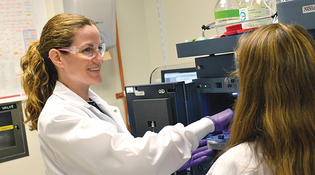 loading
loading
features“We wouldn’t have known if we hadn’t looked.”A fund at Yale is jump-starting new research on gender and health. Melinda Beck ’77, a longtime Wall Street Journal editor and columnist, is a freelance writer in New York City.  Robert A. LisakWHRY director Carolyn M. Mazure with the center’s recent undergraduate fellows. Left to right: Dhikshitha Balaji ’18, Kaveri Curlin ’19, Mazure, and Haleigh Larson ’18. View full imageTwo-thirds of the 5.7 million Americans with Alzheimer’s disease are women, as are 75 percent of people with autoimmune disorders. Men are more likely than women to develop Parkinson’s disease, be compulsive gamblers, or make successful suicide attempts. Before puberty, boys and girls have roughly the same rate of depression; after puberty, women have twice the rate of men. These are just a few examples of the impact that gender can have on health. Yet not so long ago, outside of reproductive care, women’s health and sex and gender differences were rarely studied. Most clinical trials didn’t include female subjects, and when women were included, results were seldom analyzed by gender. It was only in 1994 that the National Institutes of Health began requiring government-funded research on conditions affecting both sexes to actually include both sexes. It was another 22 years before the NIH required researchers to include female animals and female cells in their studies as well as male animals and male cells. Women were excluded as research subjects for several reasons—for instance, their hormonal cycles and the mistaken belief that women were less affected by heart disease and other major health problems. “Paradoxically, women were excluded from studies because they were ‘different’ than men,” even as people assumed that findings from studies of men would apply to women, recalls Carolyn M. Mazure, a professor of psychiatry and psychology at the Yale School of Medicine. It’s no wonder that eight of the ten drugs removed from the market between 1997 and 2001 posed greater health risks for women than for men. Mazure’s own research had uncovered several differences in how depression develops in men and women. When she became a full professor in 1998, she decided to start a center at the Yale School of Medicine that would fund research studying women, as well as sex and gender differences in health. Though the need was obvious to her, “it wasn’t part of the culture then,” she says. “We needed a mechanism to get people interested.” With a $6.5 million grant from the Patrick and Catherine Weldon Donaghue Medical Research Foundation, Mazure established Women’s Health Research at Yale. She has been its director ever since. Now celebrating its 20th year, WHRY funds early-stage research that expands our understanding of women’s health as well as sex- and gender-related health issues. Grants from its “pilot project program” have led to breakthroughs by Yale investigators on gender differences in cancer, cardiovascular disease, autoimmune disorders, brain development, and addictive behaviors.
WHRY is hardly the only Yale organization working on women’s health. The School of Nursing has a long history of research and practice in women’s medical issues; to name a few examples, the leading expert on midwifery taught there for 41 years, and recent studies have investigated factors that put black women in the US at risk for obesity and how HIV-positive women in China can reduce their stress. Faculty at the School of Public Health are studying how women’s experiences and outcomes of chronic diseases can differ from men’s. But WHRY’s focus is unique. It jump-starts research by funding the very first investigations a researcher does in order to find out if a hunch could be right and if it has potential to reveal something important. Such funding is often difficult to obtain, yet crucial for generating the initial data researchers need in order to win larger grants. The $5 million WHRY has awarded in seed grants to date has generated over $95 million in funding from other sources, funds that go directly to the researchers’ labs in order to continue the work. WHRY receives many more applications than it can fund each year. Each proposal is reviewed by experts at Yale and outside it, then ranked by WHRY’s own reviewers. “We fund as many worthy studies as we can in a given year,” says Mazure. The center is self-supporting; securing additional funding is her biggest challenge. Hilary Blumberg, a professor of psychiatry, radiology, and biomedical imaging, had noted that many gender-related health issues are multifactorial. “Why are girls’ suicide rates increasing between ages 10 and 14?” she asks. “Is it related to earlier puberty or psycho-social or cultural factors?” The WHRY funding she received allowed her to start an investigation, which led to larger grants. Using brain imaging, she studied how abuse and neglect in early childhood affect brain development differently in boys and girls. She found that abused girls have reduced gray matter in brain regions that govern emotion, and abused boys have reduced gray matter in regions governing impulse control. One of WHRY’s earliest pilot grants enabled a young psychologist, Peter Salovey ’86PhD (now Yale’s president), to assess how public-health messages could best motivate women at high risk for breast cancer to get regular mammograms. That work led to longer-term funding from the National Cancer Institute. Over the years, about half of WHRY’s grants have gone to applied research, like Salovey’s, and half have gone to studies that explore sex differences at the molecular level—where new discoveries are upending old assumptions. For example, students are often taught that the main job of the X and Y chromosomes is to produce sex hormones, which in turn make the body more masculine or feminine. “However, we now know that the sex chromosomes ‘tell’ the other 22 chromosomes in each cell how to read the genome,” Mazure says. “They play a larger role than we ever thought. And we wouldn’t have known if we hadn’t looked.” Only Yale researchers can apply for WHRY grants (though many recipients have gone on to work at other institutions as their careers progressed). Much of the research WHRY funds is interdisciplinary; Yale has the breadth and depth, Mazure notes, to bring together neurobiologists, oncologists, psychologists, immunologists, imaging specialists, and biomedical engineers.  WHRYCaroline Johnson, an assistant professor of epidemiology in the Yale School of Public Health, analyzes the chemical fingerprints of the metabolic process used by colon bacteria to find clues about sex-specific causes of colon cancer. View full imageWHRY also mentors young scientists and works to ensure that medical findings are translated into practice. And it is collaborating with the medical school on an effort to include more instruction on sex and gender differences. “Historically, the narrative of medicine has been driven by data derived from white men around the age of 40,” says Michael Schwartz, associate dean for curriculum at the school. “We are amongst a small group of schools that are beginning to aggressively attack this problem.” The school wants to address the issue “in a much more effective and holistic way in our curriculum.” Njeri Thande, an assistant professor of cardiology, undertook a yearlong effort to find out how teachers at the med school address gender difference in their classes. (She was aided by Kaveri Curlin ’19, one of WHRY’s undergraduate fellows.) Thande asked first- and second-year med students to fill out a survey after each lecture and small-group session. “We found that less than 25 percent of the sessions included any sex and gender content, and only 8 percent had an in-depth discussion,” Thande says. In March, she gave a presentation on how to give the topic more emphasis. One of her suggestions: bring up sex and gender differences in class while students are talking about the medical case studies they’ve read. “It’s so easy to broaden the discussion,” says Thande. “For example, how does the prognosis of this disease change if the patient identifies as a woman or a man?” WHRY’s undergraduate fellows program, in which Yale students receive hands-on mentored training, and the center’s work on the med school curriculum both serve a key focus for the center: developing new generations of physicians and researchers who are savvy about gender differences. It fits in well with what Mazure calls the group’s guiding philosophy: “It’s time to stop treating women as a subgroup of the human population.” She looks forward to work that will lead to better health for everyone.
The comment period has expired.
|
|